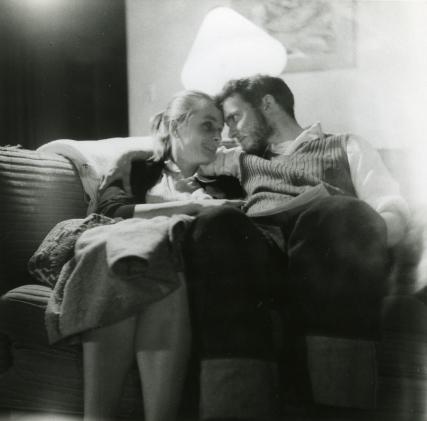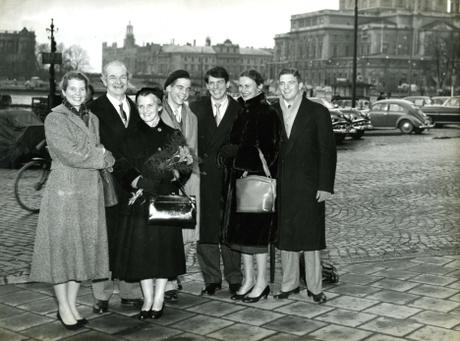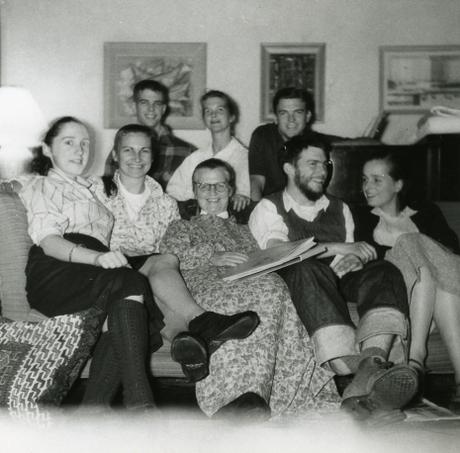
Peter and Julia Pauling, 1956.
[The life of Peter Pauling, Part 6 of 9]
The year 1954 was a tumultuous one for Peter Pauling. For one, Jim Watson had left for Caltech, and Peter lamented that his absence was felt, as he was “a positive force, albeit a bit conceited” when it came to social dynamics in the lab. At the same time, Peter’s sister Linda was preparing to move to Cambridge, where her father hoped that Peter might help her to find lab work assisting with crystal structure determinations. (Linda was quite interested in mathematics.) His sister’s imminent arrival excited in Peter visions of European exploration, and especially of skiing.
But while Peter dreamed, serious matters were afoot at the Cavendish Laboratory. Its director, Sir Lawrence Bragg, was planning to resign his Cambridge professorship to take a position as head of the Royal Institution in London. Meanwhile, the lab’s incoming director of physics, Nevill Mott, was widely known to be of the opinion that the unit’s increasing focus on biology needed to be redirected. John Kendrew was worried that the MRC unit that he and Max Perutz headed might be kicked out of the lab, or even the department, entirely.
This uncertainty both distracted Kendrew from Peter’s lack of progress on his myoglobin work, and, in retrospect, made Peter’s lack of enthusiasm for his topic all the more glaring. Indeed, while John Kendrew was worried about the future of their research, Peter was writing to his father that he was unconcerned about Mott’s approval. Rather, as was so often the case, Peter’s main preoccupation was his vehicle, this time a 1930 Mercedes Benz open touring car, described as “18 feet long and mostly engine,” that Peter was now cruising in for special occasions like the May Ball at Peterhouse. Peter’s older brother, Linus Jr., had forwarded him money to purchase the car, hoping that it would be affordable to rebuild the engine. When the cost of doing so turned out to double his investment in the vehicle, Linus Jr. thought it more expedient to simply let his younger brother have the car.
Linus Jr. and Peter formed a strong relationship during Peter’s years at Cambridge, a time period where Linus Jr. and his wife Anita made a habit of traveling around Europe during the summers. This closeness marked something of a renewal of the brothers’ relationship since they had seen little of one another during their more formative years, and as children had little in common. Now, cars in particular emerged as an area in which the two could share their exuberance. Linus Jr. reflected later that, on those trips abroad, he and his wife enjoyed Peter tagging along – his vitality, beaming smile, and friendly nature made him the life of any party.
But this was clearly only one side of Peter Pauling. Privately, he admitted to his mother that he often felt unsure of his path in life, and that he felt unable to meet the challenges of his PhD program. He often wondered whether or not he would be better off simply teaching chemistry, or helping to write his father’s textbooks. These bouts with gloom were contrasted by sudden and excited turns to sociability. Linus Jr. would later point out that their paternal grandmother – Linus Pauling’s mother, Belle – was possibly manic depressive, and was reported to have died in a mental hospital. This, he believed, was likely where Peter had inherited his own emotional instability, and it was during his stint in Cambridge that manic depressive symptoms started to manifest most clearly.

The Paulings in Stockholm, December 1954. Credit: Svenskt Pressfoto.
Linus Pauling’s frustration with Peter’s hoax “Francis Crick letter” had faded by the time that the entire family met in Stockholm for the 1954 Nobel Prize ceremonies. It was there that Pauling was to receive his highest honor to date, the Nobel Prize for Chemistry, commemorating his work on the nature of the chemical bond. After a frustrating battle to receive government permission to leave the country – by then, Linus’ political activities were causing him problems with the Passport Office – the Pauling family flew to Copenhagen where they met Peter and Linda. By then, Linda had taken up residence in the basement room that her brother had just left at the “Golden Helix,” as the Crick home on Portugal Place was now known. Once arrived, she worked for a time as Francis and Odile Crick’s au pair.
Watson returned to the Cavendish in 1955 to find the MRC unit on the verge of being squeezed out by Nevill Mott. Finally registering this threat, Peter began to panic, writing to implore his father that he vocalize his positive impressions of the unit’s work and that he recommend that the group be allowed to continue their research there. At the same time, Peter applied for a post-doctoral fellowship grant from the National Science Foundation, hoping to solidify the standing of both himself and the group by bringing additional research money into the lab.
As it turned out, Peter’s maneuver worked: he received the grant, and this was no doubt a boon to his position at a crucial time. It did little to help him in his research, however. He continued to struggle with myoglobin and, increasingly, he placed his fading hopes squarely upon the idea that mercuric tetraiodide ion crystals might be a better candidate for the sorts of analysis that Kendrew and Perutz were beginning to doubt he could complete.
As the final year of Peter’s program dawned in fall 1955, the frequency of his drives about the grounds to impress the girls dropped to what Jim Watson considered a startlingly low level. Perhaps realizing the “do or die” position that he was in with respect to his research, Peter seemed to be redoubling his focus on finishing his degree.
During this same period, Peter had begun seeing a young woman by the name of Julia, who was a student at a nearby all-women’s school. Jim Watson, curious about the situation, queried several girls that he knew from the school, but most were silent, and Julia herself became conspicuously absent as the New Year drew closer.
Meanwhile, Peter’s father had been working to prepare his son for life after Cambridge, offering him an appointment in the Caltech Division of Chemistry and Chemical Engineering as a Research Fellow focusing on the crystalline structure of globular proteins, to be determined through the use of x-ray diffraction. Pauling wrote to his son
We have a real need here for someone who has had the sort of experience in taking x-ray photographs of crystals that you have obtained. I think our effort to determine the complete structure of a crystalline globular protein is going to be successful, and that you might like to be associated with the successful effort.
Peter did not respond immediately, taking about a week to think about the proposal. It may well be that he was simply overwhelmed by both the work to be done and the festivities to be had during his final months at Cambridge. Plus, it seemed that the job his father had offered likely would be waiting for him as soon as he had finished his program in England.
Few had seen much of Peter in the run-up to Jim Watson and Linda Pauling’s practical joke of a dinner party. In response to a rumor that Watson and Linda were seeing one another, the two decided in good fun to host a get-together, thus driving speculation into a frenzy by implying an impending announcement that, in fact, was never to come. Peter was invited and did show up, but much to the surprise of the hosts, he was not his usual grinning, charming self. Instead, he seemed sentimental and full of a solemn interest in the future of his friends at Cambridge. Watson and Linda later realized that, on this particular evening, Peter was wrestling with a weighty issue: he was soon to become a father.

The Pauling family on Christmas Day, 1956. Peter and Julia sit at right.
A letter sent by Peter’s parents in early 1956 concluded with an expression of excitement: Linus and Ava Helen would be visiting soon and would look on with pride as they witnessed their son receiving his Cambridge Ph.D. In his response, Peter explained that this day, sadly, would never come. Though he felt that she was a “clever, delicate, and lovely girl,” Peter had not made Julia an “honest woman,” and for this he would be sent down from Cambridge and not be allowed to take a degree. Accordingly, this also meant that he would not qualify for the position that his father had offered him at Caltech.
When he learned of his situation, John Kendrew suggested that Peter might be able to transfer both the remainder of his fellowship with the National Science Foundation, and also the completion of his doctoral research, to the Royal Institution in London, where Sir Lawrence Bragg – his old program director at the Cavendish – was now director of the Davy-Faraday research lab. By then, however, Peter had decided to marry the mother of his child, and arrangements were quickly made by Linda Pauling for a quiet civil wedding that was out of the spotlight and not attended by Linus or Ava Helen.
Peter and Julia were married on March 13, 1956 at the Cambridge Register Office on Castle Hill. Peter’s bride was given away by her father, and with no family members other than Linda present, Peter’s sister acted as the sole adjudicator of the Pauling family’s approval of the union. Peter’s Cambridge advisor, John Kendrew, stood with him as his best man. Following the wedding, a reception was held at Kendrew’s home at Tennis Court Road, after which Peter put on his trademark grin and, with Julia, vanished in a new Porsche. Before the year was out, Linda Pauling, struggling financially and burdened by an expired work visa, returned to Pasadena.
Between 1957 and 1959, Kendrew and Perutz successfully modelled the molecular structure of myoglobin that Peter had been working on. In this, the Cavendish once more beat Caltech to the punch, as the position that Linus had offered to Peter was meant to contribute to a similar problem. Myoglobin was the first ever protein to have its atomic structure determined, and Kendrew and Perutz shared the Nobel Prize in chemistry for this achievement in 1962.
